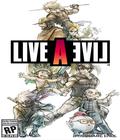Live A Live was one of the "lost gems" of the SNES era of SquareSoft. It was one of the RPGs that was never released in English, so a lot of people have never heard of it, let alone tried it out. Despite this, it was a huge inspiration for a lot of game developers. (For example, the big battle theme, Megalomania, was the inspiration for the name of Toby Fox's "Megalovania.") It's a weird and quirky game that seemed like it might be lost to the mists of time until a remake was announced. At long last, Live A Live can be played in English, and despite it being almost 30 years since the original's release, the game has stood the test of time like few other titles from its era.
The most obvious thing that stands out about Live A Live is the structure. The game revolves around seven separate protagonists, similar to something like Saga Frontier, but unlike that game, each protagonist has their own story and genre. No two characters play alike, despite sharing the same basic gameplay engine, so it feels akin to playing a series of JRPG short stories. There is a bonus chapter that brings everything together at the end, but it is only vaguely connected to the character's stories.
What really makes this interesting is just how distinctive each chapter is. One chapter can be described as "R2-D2 vs Alien," where you play as a cute little beeping robot on an interstellar cruise ship carrying a mysterious alien creature. This story has almost no combat at all and is largely about building up tension while dodging danger. Another story is basically a Street Fighter homage, where you play as a martial artist trying to defeat the world's greatest fighters while also learning their special moves. Almost the exact opposite of the other story I mentioned, it basically involves playing through the arcade mode of a fighting game — but with JRPG combat.
There are also more standard adventures, but even then, they throw interesting wrenches into the fold. One chapter has you playing as an old martial arts instructor who takes on three pupils. You can't level up, but how you fight determines what moves those pupils learn and who will eventually take over for you. Probably the most standard "RPG" of the seven chapters has you playing as a caveman, and all of the dialogue is done through pictures and grunts instead of written text.
Then there are chapters that throw everything out the window for new concepts. The Wild West chapter is a short story largely about rallying a town to battle a group of bandits, and your end goal is to set enough traps to take out most of the bandits before they can reach town. The chapter where you play as a shinobi is effectively a puzzle, where it's possible to finish the stage without killing a single person or by killing every living person in the castle you're invading, both of which require puzzling things out and potentially replaying the level.
This keeps Live A Live feeling incredibly engaging because you're not playing any one thing for long. The chapters can vary in length from about an hour to several hours, and almost every one has secret quests, bosses, or alternate endings that you can discover by replaying the levels. Even if you don't particularly like any one character, you'll be done with them quickly enough that it never drags down the game.
However, there is a pretty huge gulf in quality between some of the chapters. The "Present Day" chapter, which is the aforementioned Street Fighter homage, is easily the low point of the game. All it has going for it is the vague amusement at seeing the many references to 1994-era fighting games. Otherwise, you're fighting relatively easy enemies and trying to bait out their attack. While no other chapter is quite so disappointing, there are a clear set of chapters that feel more fleshed out and "whole," and others that could use more meat. No chapter is bad, but it's disappointing when one of your favorites ends up getting less attention.
Pretty much the only thing that the various chapters share is the combat system. Combat takes place on a large grid, with both enemies and allies on the grid. Each character has a bar that fills up and shows when they can act. When allies can act, you control one directly and can move them around the board. Every action you take allows the other character's bars to fill, and enemies can interrupt your turn to attack, so that encourages you to minimize movement. Both enemies and allies have "charge" attacks that don't go off until their action bar is filled and can be interrupted by certain attacks.
The trick is that every attack has a certain range that it can hit at. Some can hit one square away, others can hit in a circle around you, in long lines, in weird cross patterns, and so on. It's key to position yourself so your best attacks can hit the baddies, but at the same time, you need to be cautious of enemy ranges. The more challenging bosses have attacks that will absolutely wreck your face if you approach them haphazardly. Some punish you for staying at range, some for getting close, some for standing in front of them, etc. It's a fun positioning game to remain in your optimal range while staying out of theirs.
The result is that a lot of combat feels like a puzzle, where you try to figure out the best way to take out your enemies without giving them a chance to hit you. Even random enemies can hit hard if given the chance. Status effects are powerful and viable, so you can sometimes shut down entire groups of enemies with sleep spells or paralysis. There are also special kinds of enemies who come in large numbers but have a leader unit; if the leader unit is killed, you instantly win the fight, but reaching the leader unit sometimes involves careful thought. Death is not necessarily a game over. If any character is left alive, they can use a healing spell to instantly revive downed allies. If a downed ally is hit by any other attack, they are ejected from the battle and can't be revived.
The combat system is easy once you get the hang of it. Because of the bite-sized nature of the gameplay, the overall damage numbers aren't super high. Characters probably won't go above level 17-18 by the very endgame, and gaining an extra two or three points in a stat has a significant outcome. The game is weighted in your favor, so you can do absurd amounts of damage with a bit of prep, but it keeps the "rocket tag" nature of gameplay, where you can also get wrecked pretty easily; it makes it harder for enemies to do if you're nailing them for 999 hit points.
Live A Live is a remake of a 1994 SNES game, but it is a rare remake that manages to improve on the original without losing its charm. There are a lot of under-the-hood changes — easier saving, better menus, a convenient map that shows where the next goal is — that go a long way toward making it friendlier to play. There are some balance changes, and it has enough weird or esoteric things that you'll be able to tell it's a 1994 JRPG. It's exactly what a remake of this kind should be, smoothing out the rough edges without removing the game's uniqueness.
Nowhere is that more apparent than in the visual upgrade. It's hard to appreciate how massive a visual update Live A Live is over the original version without seeing them side by side, and it's a world of difference. Larger and more animated character models, breathtaking background work, and an absolutely massive amount of care and effort put into making the game look like an improved version of the 1994 original rather than something else entirely. It still has some of the basic animations and goofy designs of an SNES game, but in this case, that's a plus, not a minus.
Nowhere does Live A Live shine more than in its music. The original was one of the first works by masterpiece composer Yoko Shimomura, and it has long been considered one of the most exceptional JRPG soundtracks out there. Even with her work on games like Kingdom Hearts and Xenoblade Chronicles, Live A Live is still held up as one of her best works. The remastered soundtrack adheres to that while making everything sound amazing. It is incredibly impressive how many amazing tunes are worked into one little game, and the variety and depth of the music makes hearing each new one a treat. On the other hand, the voice acting is more mixed. Some of it is quite good, some of feels awkward, and there are a couple of cases of, "Is that the accent you're going with?" that stand out like sore thumbs. For the most part, the voice acting improves the experience and gives a bit more weight to combat dialogue.
Live A Live is the ideal way to experience a cult classic game. It maintains or improves on everything that made the original game distinct while polishing it enough that some of the more dated design elements don't detract from the whole. It's a weird, quirky, and distinct JRPG that to this day is unlike anything else on the market. It won't be for everyone, but if you're a fan of JRPGs, then you owe it to yourself to give it a shot. What other game can you have a cowboy team up with a caveman and the pilot of a giant robot?
Score: 9.0/10
More articles about Live A Live











 Live A Live is an RPG where you play seven stories featuring a variety of protagonists, time periods, and gameplay styles in any order you choose, now with newly remastered HD-2D graphics.
Live A Live is an RPG where you play seven stories featuring a variety of protagonists, time periods, and gameplay styles in any order you choose, now with newly remastered HD-2D graphics.




